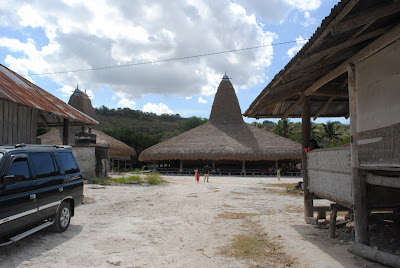LOVINA BEACH
We arrived at Lovina Beach on the northern end of Bali on the 18th Sept after an overnight sail from Medana Bay, Lombok. There are all sorts of hazards when sailing at night, but the Indonesians take it to a new height. As if unlit fishing boats, boats with flashing lights of all colours, or with downright incorrect lights is not enough to keep you awake and alert they also have these fish traps that are unlit, dark in colour (so you can’t see them) and drift around permanently attracting fish to shelter under them. Makes finding the fish to catch them so much easier, but it means that we try to avoid sailing at night if we possibly can. Sometimes this is not possible so we then try to sail when there is a decent moon.
INDONESIAN FISH TRAP
There are already quite a few boats from the rally here in Bali, but there are still plenty more to come. We were talking to Dianne and Bernie off First Light II, and Dianne and I both thought that the other looked familiar. So, as you do, you try to find common ground, and we worked our way back to Warragul. Dianne turns out to be Dianne Blackwood, not only did we go to the same school, but we were in the same class all through high school!! Amazing.
Well, once again we hired motorbikes so we could explore Bali. Good thing we practiced in Lombok as the traffic here is far worse. Chris and I (Amulet) and David off Mirage III plus us took off early to find the supermarket. They are rare things indeed in Indonesia so if there is one it needs to be checked out. After that we decided to head up into the mountains to see what we could see. Lots of Hindu temples and shrines along the roads, spectacular views which no camera can do justice, and all the sights and smells of Bali. The air was filled with the aroma of drying cloves, and further up the mountain there was the sweet smell of oranges. The roads are very much better than on Lombok, although we were doing a loop up through the mountains and once on top found the road was closed so we had to come back down the same road. Tomorrow we will head west and see how we go.
BALINESE TEMPLE
On advice from a local it was decided to go up the other side of the loop that we missed out on when we had to turn back. It was an overcast day with the threat of rain constantly over our heads as we headed for the hills. We passed through Monkey Mountain and guess what we saw there? Yes, you got it: monkeys. Just look how cute these are.
MOHAWK TRIBE
Almost at the top of the mountain we came to a market or Pasar in the local jargon. Have picked up enough to be able to bargain with the best of them, the secret is you must be prepared to walk away if they don’t come down to your price. Lots of fun. The fruit and vegie market was the best we had seen, with very fresh produce. I bought a cauliflower that had just been picked! We all came back down the mountain loaded with stuff, even starting to look like the locals with the way they transport everything by bike. If it not on a bike it is usually on someone’s head, the amounts they move that way is incredible. There were even women carting rocks in baskets on their head. Lovina Beach is a tourist area so there are plenty of restaurants that cater to the western taste, but with Indonesian prices. Main meal, sweets and beer came to $19.00 for the two of us. Sure beats cooking.
Next came the official functions and Gala dinner. The music and dancing in Bali are very different to what we saw in the southern islands. The girls are beautiful, elegant and very graceful, a pleasure to watch. Dinner was served at a local restaurant, and unlike everywhere else there was only one speech to welcome us to Bali.
BALINESE DANCER
Today we went to the bull races. Well they don’t actually race them as we know it; it is not about who is first, but who can control their bulls the best, and who has the best trained bulls. They are all decked out with bells and headdresses, and pull a sled type arrangement. The jockey sits on a thin piece of timber attached to the yoke between the two bulls. When they called for volunteers naturally I off Amulet and myself put our hand up. It was great fun; I won and was interviewed by the local TV station. What a buzz that was!
AREN'T THEY CUTE!
This afternoon the kids from kindergarten were performing, and what a great job they did. A photo just doesn’t do it justice. Bali has been great, every night there have been cultural shows, but the stage has been set up on the beach, so all the locals and other tourists can come and watch as well.
BALI KINDERGARTEN KIDS
Well all good things must come to an end and Bali has been a very enjoyable stop. Tomorrow we are off to Karimun Jawa, which is 340 nm from here, so that will take 3-4 days.































